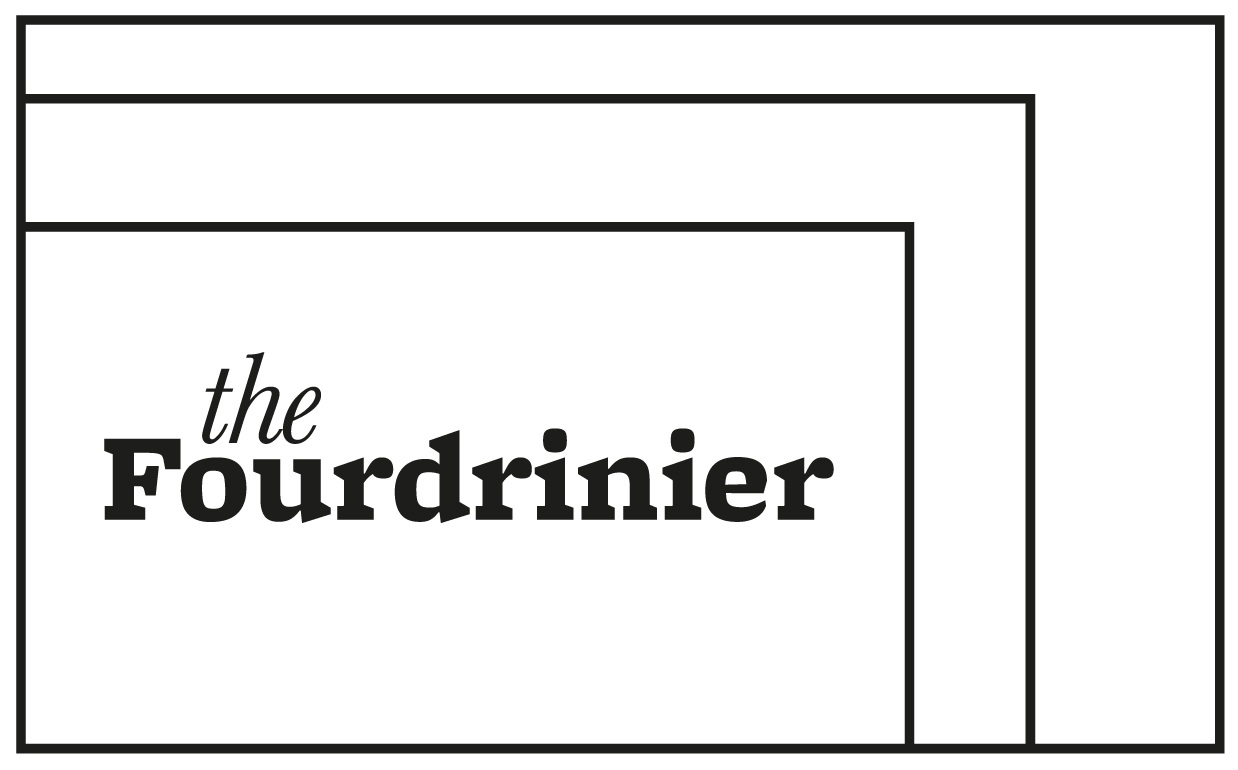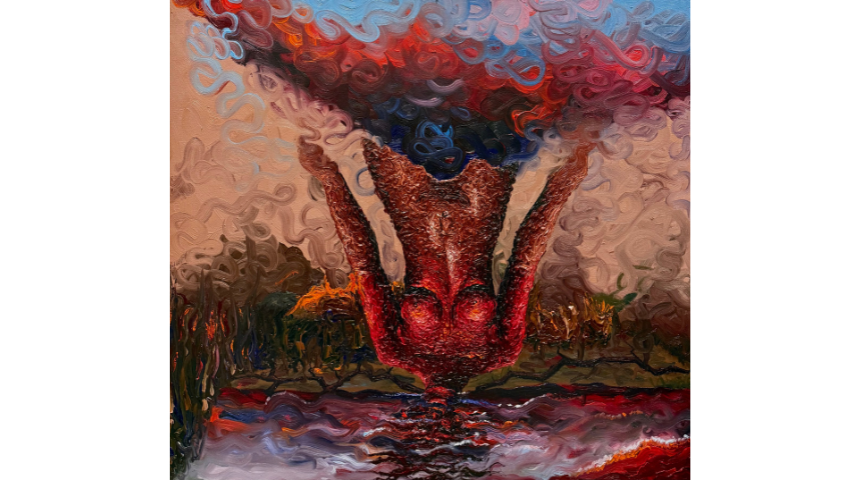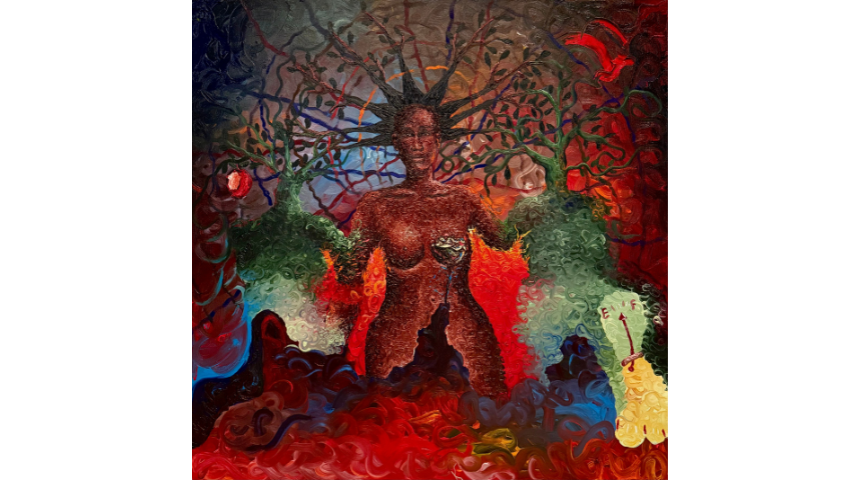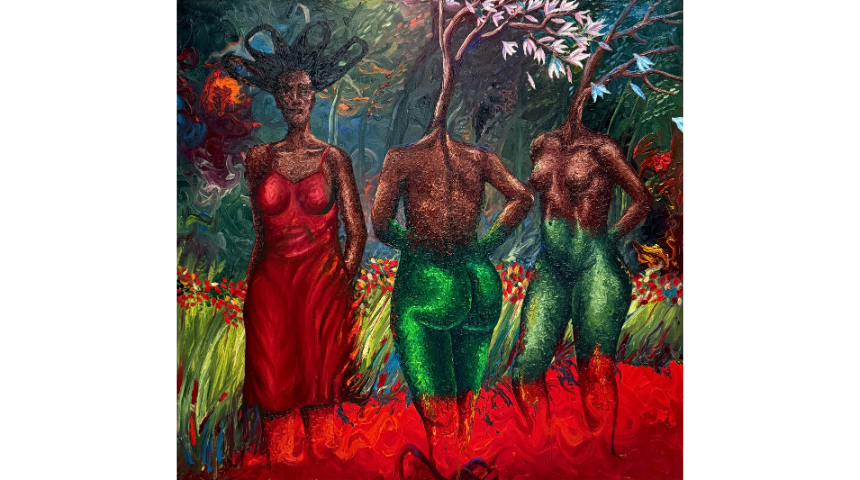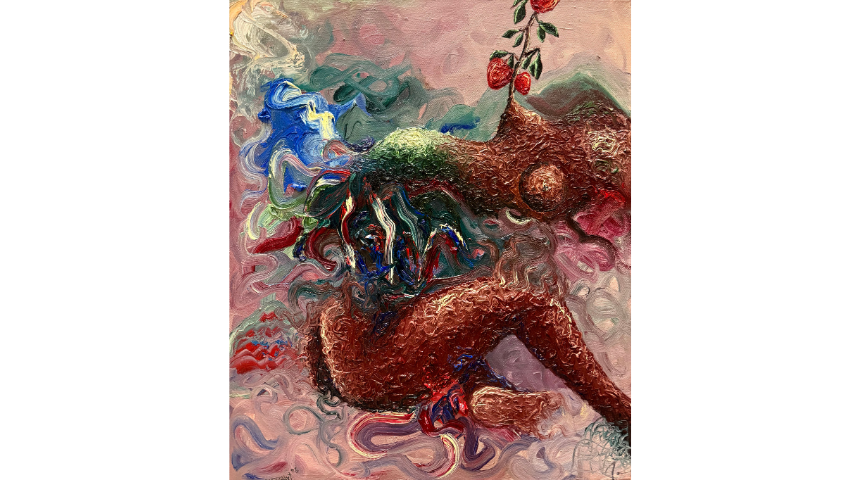REVIEW Aug 2025 Chidimma Urunwa Ikegwuonu: Ode to Becoming (two tales, one body) at PINK Manchester
Jo Manby
Chidimma Urunwa Ikegwuonu In the Beginning, She Was The Soil oil on canvas
The first UK solo exhibition of work by Nigerian born artist Chidimma Urunwa Ikegwuonu, ‘Ode to Becoming (two tales, one body)’ was presented at PINK Manchester between 25 – 27 July 2025. the Fourdrinier editor Jo Manby reviews the show of new oil paintings following a feature in our June issue that focused on works painted earlier on, at the beginning of the year.
Read the feature here: https://www.thefourdrinier.com/feature-jun-2025-the-paintings-of-chidimma-urunwa-ikegwuonu
Solo show: ‘The Weight of Dream’ at Mill 1 Gallery, Oldham 7-11 August 2025
PINK is a new gallery, artist studios, and events space dedicated to advancing interdisciplinary research, innovative practice, and collaborative exchange. Visitors approach by crossing a courtyard behind the A6 in Stockport, Manchester. Up concrete steps and through plate glass doors, PINK is housed in an ex-office block and recently staged a notable exhibition of brand-new oil paintings by Chidimma Urunwa Ikegwuonu: ‘Ode to Becoming (two tales, one body)’. A visual storyteller, the artist presents works where richly coiling and uncoiling skeins of paint conjure mysterious figures out of hypothetical spaces. These paintings are an emotional ride to witness. A language of power, resilience, the spiritual feminine. A voice for the voiceless, the unspoken experiences of women and young children.
The crowd that saw the show was buzzy and diverse, reactions to the works overwhelmingly positive. Nineteen paintings ran single depth round one long and one short wall of the gallery space. The opposite long wall comprises the typical 1970s office windows, the short wall being the entrance and reception area. PINK fosters long-term, supportive relationships with artists, often offering their first exhibition opportunity in Manchester and encourages them to explore overlapping objectives, research, and creative collaborations through an ambitious programme of residencies, exhibitions, and events. This is the first UK solo show for an artist who has exhibited widely across Nigeria, India and Mexico.
Having first seen Chidimma Urunwa’s work back in the springtime of this year, I was captivated in ‘Ode to Becoming’ once again by the intensity with which these works command presence; there is a lyricism to the handling of the paint that is vivid, textured and alive. These snaking curves, as tightly packed as a woven or crocheted fabric, create a fully realized painterly connection with the viewer as they metaphorically unfold for us transformational narratives of unravelling and reforming.
Following on from the spellbound three-month period in which she painted the works I wrote about in my previous article (here), only one of which features in ‘Ode to Becoming’, here is an entirely new set of works, again painted in a burst of inspired, industrious studio time. Chidimma Urunwa seems to have the capacity to tap into her subconscious, the very source of her creativity, and simply allow these images to flow.
Another change is that these works are less planned and even more spontaneous. The earlier body of work, of which Ode to Becoming is one (originally entitled Life), was characterized by careful composition, a balance between form and colour. There was an intensity but this abstracted impasto was restricted mainly to the backgrounds, from which figures such as the blindfolded woman in unCERTAINTY or the female transforming into a blossoming tree in Her Silence Bloomed into Witness (Omenelū) emerged.
It’s as if another layer has been pulled away. As if the painter is lifting the veil of reality and looking beyond. Into some primordial realm. Letting the paintings come from the backgrounds. That complex, roughly blended, thickly brushed creamy tangle has now taken on a vivid and newly expressive life of its own. The work is like automatic painting, where there is little planning and a greater intuitiveness. The brushwork has become freed up, looser, more of a flourish, more of a personal pictorial language, less painstaking and less descriptive. A matter of giving away feelings, intuitions, letting emotion rise to the surface.
All the figures – those that are clearly defined, that is – are female or are small babies or children. Other beings sometimes loom in the backgrounds which might suggest forests or stormy landscapes, or the interior of an indeterminate building, but they could be the spirits of ancestors, or sprites of the natural world, or some other kind of apparition. ‘I see the human form as a tool for conveying emotion and narrative, so I don’t feel confined to strict realism,’ says Chidimma Urunwa. ‘Instead, I like to experiment and push boundaries, using the figure to express deeper meanings and capture the essence of what I’m trying to say, rather than focusing on perfection or accuracy.’
Chidimma Urunwa Ikegwuonu The Alchemy of Gaia’s Bloom oil on canvas
Take The inversion of Apophasis II, an abstraction in green, but with a figurative head, chest and forearm. The female head is slashed by a green and yellow brushstroke, a mixture of colours roughly blended as the brush is pulled across the underlying dry impasto of the face. The figure appears to be leaning on a bank of vegetation which is brushed in ringlets of golden brown, lemon and lime paint. Chidimma Urunwa explains that this is more to do with articulating the sense of the feminine as intrinsically tied in with the natural world. The title implies the opposite of apophasis, itself a rhetorical means of bringing up a subject by denying that one will speak of it. Thus, this double-negative is unloosed and reversed to imply a truth that emphatically will be spoken of and will not be denied. It’s about exposing taboos, unchaining pent up sorrows and anger, naming wrongs and calling out injustices.
Mother of the Verdiant Realm reveals a figure bearing a green child. A mother whose hair is entangled with the line of trees and plants at her head holds a human promise of the future. Other figures, a green being and a smaller, human coloured child, emerge or disperse among a coiling passage of red, green, blue and pink strokes worked into a dark background. They might indicate that the natural world is a cycle, it brings forth mankind who then proceeds to ruination, and then at some point, a mother must birth a green child again, so that the planet can recover.
In an adjacent work, The Past Bloomed in Her Arms, a woman holds a green childlike figure, caught on the brink of life. She stands in a silt riverbed among quivering reeds and rushes, a sky overhead of cherry pink and plum, a figure rooted in earth and sky as well as the rivers that run through the land. ‘In a way, colour is both a reflection of the world around me and a personal language I’ve developed to communicate my inner thoughts and feelings,’ Chidimma Urunwa explains. ‘It’s something that has evolved over time, and I’m always experimenting with how different shades can enhance the message I’m trying to convey in each piece.’
The Inversion of Apophasis foregrounds a figure, head in a river, legs in the sky, caught between air and water, a symmetry that feels natural and unforced. The compositional harmony of a canvas divided into horizontal thirds plays off a sensitively attuned balance of blues, reds and browns that flicker tremulously under the gestural interplay of brushstrokes. This is an incredibly powerful image, like many of Chidimma Urunwa’s works. Rather than spending time weighing up what colour to put where, she seems to have painted this, as with others, quickly and instinctively, her pre-acquired knowledge of the technicalities of colour and form facilitating this subconscious flow. ‘By broadening my knowledge and exploring various art movements, I’ve been able to blend different styles, techniques, and colour palettes into my own practice,’ she says. ‘I believe that art should be fluid and dynamic, influenced by both personal heritage and global experiences. My approach to colour is not confined to one place or time; it evolves as I learn, research, and interact with different artistic traditions.’
With the gallery space at PINK saturated with the smell of linseed oil, and surrounded by these dynamic images, I’m keen to know how her work is made, what the process is. It looks quickly executed, wet-in-wet with oil. ‘I’ve maintained the same technique,’ Chidimma Urunwa explains. ‘I work predominantly with oil colours, which I apply heavily, in an impasto style. Everything is done with oil colour, I use linseed oil to make it more liquid in form so I can control my strokes.’ Because oil takes time to dry, unlike acrylic, ‘I don't need to work that fast out of fear of it drying.’ We chat about this greater fluency than the previous body of work. ‘Yes, the process has become more intuitive and confident, shaped by continued exposure, experience, and trust in my creative instincts.’
In a work such as the commanding SHE Who Became the Earth, statuesque women at one with the elements and nature are depicted with figurative skill. In other paintings, figures are stretched or distorted to combine with expressive paint handling and colour sense and project a deeper intensity of feeling. In I Am Not Broken, a pear-shaped figure, anchored to the earth by a silver-grey rope, with an etiolated neck tipped backwards in a curve by the weight of the head, crouches in a rudimentary landscape. A distant volcanic mountain range rumbles on the horizon and overhanging foliage cascades to meet its tangled pink and grey flecked smoke, a crisscross of red and black twigs at the figure’s feet. The work contorts the figure to express meaning. There is a sense of retrieval of power, of salvaging the self and reclaiming space coupled with a feeling of yearning and longing to finally break free.
Chidimma Urunwa Ikegwuonu SHE Who Became the Earth oil on canvas
In Unknown, a twig bearing bright red fruit sprouts from the female breast of a figure with a wrenched apart torso. There is a dislocation at the stomach area that could refer to the dysmenorrhea that Chidimma Urunwa has spoken of – the extreme pain of menstruation experienced by some women. She explained that although this was not a conscious reference, and indeed was the first time she had noticed it, it might be a subconscious allusion because she often paints through a feeling of physical pain. There is an impression of physical sensations overpowering the figure with body-splitting agony as a thickly loaded brush is pulled between the ribcage and the pelvis of the arching figure, marks of paint switching and writhing between guttural reds and high pitched electric blues.
In Chidimma Urunwa’s works, the figure is often depicted in a non-specified, indeterminate space, as in Unknown, where scale, time, era and other coordinates do not signify. At times a landscape materialises, as in I am Not Broken. In others the place is an interior, but it is as charged with emotional and spiritual currents as the liminality of the majority of the works. When the walls bend unlocks a view into an enclosed space with foliage above that gives an impression of redemptive nature overlooking the scene. A large room with a central hearth or stove, a figure with open legs in flame red and orange, a figure on fire. No torso, no head, these are subsumed into the central pillar or knocked so far back that they merge with a thickly brushed shadow of plum and mauve-black.
In the Beginning, She Was the Soil depicts a woman and a baby, again, in an interior. Hosts of beings or spirits surround the mother who attempts to feed the child at her breast, self-consciously aware of being watched over. The pinkish red cloth that covers the table is alive with sprites that emerge and retire back into the pattern of the fabric. But they are active – leaping, picking things up, putting them down, writhing and tumbling. The material world is interwoven with the immaterial, the spirit world in immediate proximity. A mixture of personal experience and an interest in women’s issues seems to ignite under the flame of artistic expression in each of the works in ‘Ode to Becoming’.
Chidimma Urunwa Ikegwuonu Unknown oil on canvas
Interest in contemporary Black British and African women artists’ work is experiencing an upsurge. Saeed Kamali Dehghan wrote in the Guardian earlier this year about how women artists are surpassing men in terms of sales in the African art market.(1) MOMAA cites the biggest percentage growth in the art market of 2025 as stemming from African women artists within the Contemporary African and Diaspora Artists sector. Julie Mehretu, Amy Sherald, and Njideka Akunyili Crosby all achieved new price records in the leading auction houses. What’s also interesting about MOMAA’s report is the trend set by young, more diverse and usually female art collectors that seems to be part of this market shift.(2) Siti Osman, philanthropy and patrons manager at The Yinka Shonibare Foundation (YSF) is cited in ArtTactic: ’60% of the population in Nigeria is under 30. That is a lot of youthful, creative energy.’ He also says: ‘Be humble, and enter a dialogue with the creatives, the makers, and the art lovers. Hear what moves them, because it might move you too.’(3)
I asked Chidimma Urunwa about how she found her work had been received, now that she has had a UK exhibition. ‘With many people expressing a strong sense of connection and appreciation for the stories I share,’ she told me, ‘it feels rewarding to see audiences engage and connect with themes and the art work.’ The way that Osman encourages a sense of connection and understanding seems to echo in her impression of the art ecosystem in Manchester and Greater Manchester. It has, she says, been ‘vibrant and increasingly welcoming. There’s a strong sense of community and support for diverse voices, which creates exciting opportunities for artists like me to grow, connect, and share our stories.’ With work as powerful and groundbreaking as Chidimma Urunwa’s, I can’t wait to see where she takes these stories next.
Footnotes
(1) Saeed Kamali Dehghan, The Guardian (24 February 2025) ‘No longer on the margins’: how women are outperforming men in Africa’s art market, available at: https://www.theguardian.com/global-development/2025/feb/24/female-african-artists-women-art-market-auction (accessed 30/07/2025)
(2) Dr. Abigail Adeyemi, Ed., MoMAA (4 June 2025) 2025: The Year in Review for Female Artists in the Art Market, available at: https://momaa.org/2025-the-year-in-review-for-female-artists-in-the-art-market/ (accessed 30/07/2025)
(3) Siti Osman, cited by Margaret Hong, ArtTactic (19 May 2025) Metamorphosis: The Modern & Contemporary African Art Scene, available at: https://arttactic.com/editorials/metamorphosis-the-modern-and-contemporary-african-art-scene (accessed 30/07/2025)
All works dated 2025.
Chidimma Urunwa Ikegwuonu Unknown oil on canvas
